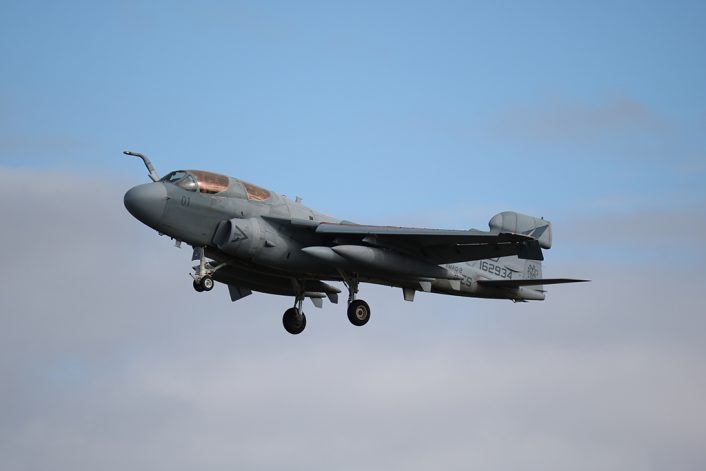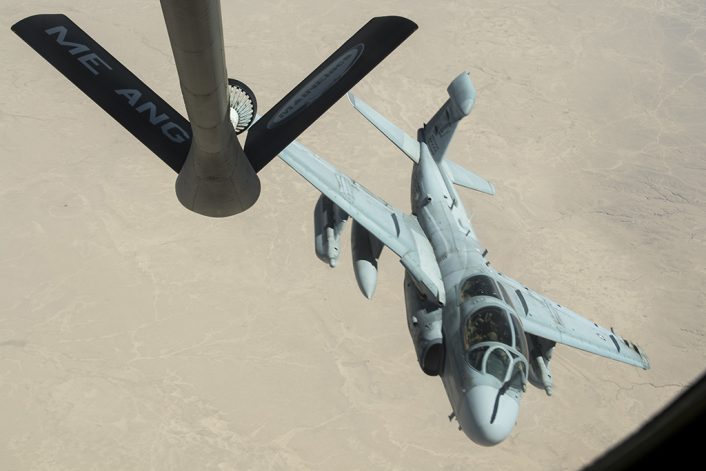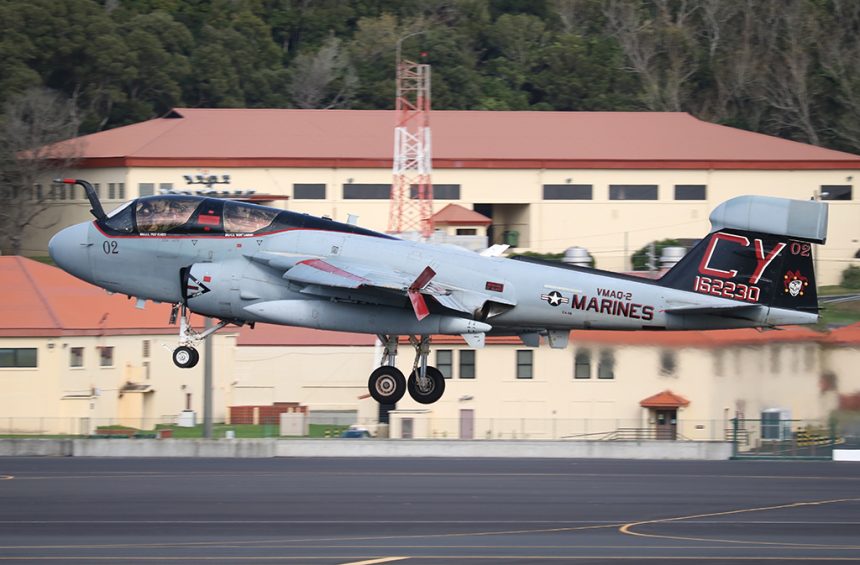The final operational chapter of the Prowler career has just been written by the U.S. Marine Corps “Death Jesters” and their six EA-6Bs jets.
Marine Corps Tactical Electronic Warfare Squadron-2 (VMAQ-2) “Death Jesters”, the last of four Marine Prowler squadrons, has just completed its final deployment in Qatar, with the last six EA-6B in the U.S. military inventory.
Four aircraft, using radio callsign “Trend 01-04” landed at Lajes, Azores, on their way back to Marine Corps Air Station Cherry Point, North Carolina, from Al Udeid, Qatar, on Nov. 12, 2018. The remaining two aircraft would follow in a couple of days (they were left behind due to technical issues).
The first pair (“Trend 01-02”) was supported by “Blue 52”, an Air Force Reserve KC-135R operated by the 916 Aerospace Refuelling Wing at Seymour Johnson AFB, North Carolina, that also landed at Lajes.
Interestingly, one of the aircraft, 163047/CY-05, sported “Agent 007” markings inside the split trailing edge air brakes as the following image shows:

The EA-6B was born out of military requirements during the Vietnam War. It entered service in 1971 and 170 aircraft were produced before the production was terminated in 1991. For more than four decades, the Prowler has been “at the forefront of military electronic warfare allowing high-profile air combat missions.”

During the last deployment the aircraft have supported Operation Resolute Support and Freedom’s Sentinel in Afghanistan as well as Operation Inherent Resolve in Iraq and Syria. The primary mission of the aircraft was to support ground-attack strikes by disrupting enemy electromagnetic activity and, as a secondary mission, to gather tactical electronic intelligence within a combat zone, and, if necessary, attacking enemy radar sites with HARM missiles.
Despite their age, the EA-6Bs have been among the most important assets in the air war against Daesh: they eavesdropped “enemy” radio signals and jammed those frequencies in order to prevent terrorists from talking one another on the radio or cell phone, or use portable transmitters to trigger IEDs (Improvised Explosive Devices).
Actually, rather than the obsolescence of the onboard EW (Electronic Warfare) sensors, the main issue that has affected the Prowler fleet what has been keeping the legacy aircraft in the air.
“It’s not an easy airplane to work on. Nowadays, components tell you they need to be replaced, skilled troubleshooting doesn’t exactly exist the way that it used to and working on this plane is very much a different skill,” Lt. Col. Andrew A. Rundle, VMAQ-2 commanding officer, said in a recent release.

“You could think you know what is wrong with it and you fix what you think is wrong only to find it had nothing to do with what was wrong and it didn’t help or fix anything,” explained Gunnery Sgt. Kevin Randall, VMAQ-2 maintenance control chief. “You could troubleshoot for days in the wrong direction, but because it is an old airplane there are lots of wires and things that don’t even go to things anymore and through updates and upgrades there are things that cause problems that you never would have thought. Changes that were made 10 or 15 years ago have surfaced and reared their head.”

On the maintenance front, Randall acknowledged some challenges with those who have come to the EA-6B in recent years with the aircraft’s sunset on the horizon.
“Almost every air mission that people have heard about since the 1970s likely involved a Prowler in some way and we don’t talk about it,” said Randall. “I think that’s the cool thing we all know in the back of our heads. The public reads that bombing missions happened here or we got so and so or completed this mission and you read about the flashier airplanes such as the B-1s, the F-18s, the stealth fighters that took off from wherever, but you never read about the Prowler that had to be in the area days prior or had to be around the area to complete its mission to allow the bigger mission to happen.”
The U.S. Navy retired their Prowler fleet in 2015, shifting the EA (Electronic Attack) workload to the EA-18G Growler. The Death Jesters will retire the EA-6B Prowler in 2019, the second-to-last U.S. Prowler Squadron, the VMAQ-3 Moon Dogs, was deactivated last spring.
All images courtesy APS – Associação Portugal Spotters (Portuguese Spotters Association) unless otherwise stated.








